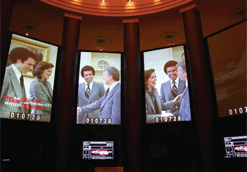As demand increases for dual-stacked large-venue projector solutions, smart integrators must discern which vertical markets within the commercial AV installation galaxy offer the best potential for growth.
“In the museum market, which is a niche market, large-venue projectors tend to be reserved for the theaters where there is an introductory blockbuster film,” said Sue Lepp, SVP, Design and Production (D&P) in Lorton, VA. “Occasionally, there is a largevenue projection need in the museum proper, but it’s more typical to see large LCD screens and mini-theaters.”
In a large rotunda of the Jimmy Carter Presidential Library and Museum, an exhibit integrates six Digital Projection HD600 Titan projectors on Da-Lite high-contrast, 13-foot-high projection screens, augmented by four Sharp PN-S655UP 65-inch LCD screens.
D&P, with a complete AV integration group under its umbrella, recently completed an extensive renovation for the Jimmy Carter Presidential Library and Museum in Atlanta, GA, a research facility and museum. The museum’s exhibits highlight the prepresidency, presidency, and post-presidential periods of Jimmy Carter’s life.
“The project features two projector installations of note,” said D&P’s Dale Panning. “In the large rotunda, ‘A Day in the Life of a President’ exhibit depicts presidential activities from 5:30 a.m. until end of day. This was accomplished by integrating six Digital Projection HD600 Titan projectors on Da-Lite high-contrast, 13- foot-high, vertically oriented projection screens, augmented by four Sharp PN-S655UP 65-inch LCD screens, creating a 10-screen synchronized show with surround sound. This projection system was successfully incorporated in the sleek design due to the fact that mirror bouncing was unnecessary. This model Titan is designed to be positioned directly on its side.”
In the post-presidency exhibit gallery, an 18-foot, Corian-topped interactive table shares with visitors the many interests and endeavors of the former president, such as election monitoring and disease elimination. In close collaboration with the Carter Center staff and with Cortina Productions of McLean, VA, the D&P design team responded to the Carter Family’s desire to have a highly interactive experience that appealed to all age groups
“The table itself serves as a projection surface,” Panning explained. Embedded within it are six IRTOUCH T46 infrared touch frames, while six overhead Digital Projection dVision 1080P-XL projectors provide imaging for both the interactive table and teaser text on the floor around the table. “Computer sources located in the base of the table provide interactive content to the six projectors, audio, the touch frames, a Sharp PN465UP LCD screen, and intelligent lighting that projects an airplane flying across the table,” he elaborated.
With the logical progression of advancing technology, Panning observed, these formerly hulking projectors have become smaller, lighter, brighter, and quieter. “These are criteria for the exhibit designer to pull the large-venue projector out of the darkened theater and into main galleries featuring large images coexisting with show lighting, and blended with architectural elements to create high-impact and immersive visitor experiences.”
In terms of other applications for evolving projector technology, Sanyo has seen a surge in requests for complete systems for houses of worship, according to Sam Malik, director of sales and marketing for Sanyo Presentation Technologies. “In talking with clergy and IT directors from small- and large-venue worship facilities, we find they all have the same interest and concern—how to retain and increase the participation of their followers as it becomes difficult to maintain attendance and interest from younger participants used to technologies such as the internet, satellite TV, and cell phones,” Malik elaborated.
Clients in the house of worship market recognize the need to create a more engaging and interactive environment using systems that feature large-venue projectors such as Sanyo’s PLC-XT21, PLC-XP200L, and PLC-XF71 high-brightness models, he said. “Their displays may include song lyrics, local camera feeds, or images and videos. Many houses of worship include very high-tech systems for their presentations, wellreceived by patrons of all ages.”
Meanwhile, the strength of the education segment was demonstrated at a recent meeting and tour of Boston College, where more than 250 Sanyo PLCXT21, PLC-XT16, and PLC-XT35 projectors are installed, Malik noted. “Jim Clements, project manager at BC, commented that the Sanyo projectors have made teaching easier on both the faculty and students, offering enriched content and materials to enhance the learning experience.”
AV integrators are recognizing these and other opportunities in supporting the higher-education segment, as it usually results in larger-ticket sales with better margins for providing sales and support after the installation. “When they meet the customers’ expectations they typically form longterm relationships with the schools, which results in long-term business.”
In terms of buzz-worthy technologies like 3D, Keith Yanke, NEC Display Solutions director of product marketing said, “Currently, we are not seeing too much demand for systems to show 3D content, except in NEC’s digital cinema products for theaters, where 3D is driving very fast adoption of 3D digital cinema DLP projectors. But in the traditional largevenue applications, the demand for 3D is not driving technology purchases too much at this point, although we’re watching that closely.”
NEC’s large-venue projector models include the stackable NP3250 and NP3250W, which can deliver 20,000 lumens in stacked configurations, or the single-unit NP4100 and NP4100W, which deliver about 5,500 lumens.
“Vertical markets that are buying more large-venue projectors include education—for large lecture halls and auditoriums—houses of worship, and, in some cases, transportation facilities such as airports, and even retail,” Yanke noted. “In some of these markets we see customers replacing single units with new stacked units to achieve the highest possible brightness. The stacked configuration also provides redundancy in case a lamp wears out. We also see these customers using high-gain, curved screens to reject ambient light and allow a brighter image.”
The newer generation projectors are brighter, use less power, offer longer lamp hours, and are more efficient overall, Yanke said. “Networkability is a key consideration for facilities that cover a large footprint, such as campuses, so you can centrally monitor and control projectors in far flung locations.”











